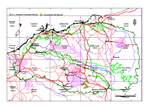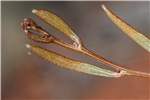Click on images
to enlarge


, habit, BRM 8036_sml.jpg)
Photographer: B.R. Maslin

Photographer: B.R. Maslin

Photographer: B.R. Maslin

Juvenile growth habit. Photographer: B.R. Maslin

Photographer: B.R. Maslin

Photographer: B.R. Maslin
, pods green, BRM 8036_sml.jpg)
Immature pods. Photographer: B.R. Maslin

Immature pods. Photographer: B.R. Maslin

Photographer: B.R. Maslin
, seeds (close), MET 19124, FM_sml.jpg)
Seed from one herbarium voucher. Scale in mm. Photographer: F. McCallum
Botanical name
Acacia aneura var. intermedia Pedley, Fl. Australia 11B: 489 (2001)
Common name
Mulga
Note
Acacia aneura and related species form a very complex and polymorphic assemblage of taxa with A. aneura itself the most variable (see Miller et al. 2002 for discussion). These species are currently under review therefore the classification here of Pilbara entities referable to A. aneura is provisional. Currently 10 varieties are recognized within A. aneura (Pedley 2001) of which six appear to occur in the Pilbara. These varieties encompass most of the variation in Mulga in the Pilbara and are the entities upon which this Wattles of the Pilbara treatment of Mulga is based. It is often difficult to distinguish between the varieties, and between A. aneura and related species (especially A. ayersiana and A. paraneura ) on account of seemingly intermediate forms. In past literature it is often not possible to know to which of the varieties the information applies. Therefore, we have assembled these data under the heading of A. aneura . The data presented below for A. aneura var. intermedia is derived from our field and herbarium studies of only the Pilbara plants of this entity.
Description
Large bushy shrubs 3-5 m tall, either sub-rounded or obconic with a sub-rounded crown, with 2-3 or more main stems from ground level, the main stems straight or somewhat crooked, the upper branches straight. Branchlets obscurely ribbed at extremities, ribs not resinous or if so resin translucent and not pronounced, sparsely to moderately sericeous, becoming glabrous with age. New shoots dark brownish and resinous when dry. Phyllodes narrowly linear to linear elliptic, 60-100 mm long, 2-4 mm wide, straight to incurved or sometimes shallowly sigmoid, pale green to greyish green or sub-glaucous, with a silvery sheen; parallel longitudinal nerves very fine and of uniform prominence; discrete marginal nerve absent or very poorly developed and best observed on young phyllodes (i.e. thin, yellowish and slightly resinous; phyllode usually needs to be viewed side-on to see this nerve, when phyllode is observed in plane view the nerve is not or scarcely visible); apices acute to acuminate. Inflorescences simple; peduncles 4-10 mm long; spikes (10-) 20-30 mm long (as judged from length of receptacle). Sepals free, linear-spathulate. Pods 15-30 (-40) mm long, 7-14 mm wide, finely and obscurely reticulately nerved, sparsely to moderately sericeous, aging ±glabrous, light greyish brown or mid-brown; marginal wing narrow (0.5-1 mm wide). Seeds oblique or transverse in the pods, 5-6 mm long, 3 mm wide.
Distribution and ecology
The Pilbara populations of this variety are confined to a small area in the vicinity of West Angelas in the central part of the Hamersley Range, as well as west of Tom Price in the vicinity of the Hardy River. Grows in stony red-brown loam, sandy loam or clay-loam on slopes and tops of low hills and breakaways, sometimes along diffuse watercourses. The overall range of var. intermedia is given by Pedley (2001) as occurring in the arid zone of all mainland States except Victoria.
Flowering and fruiting period
As with other forms of Mulga it is most probable that flowering and fruiting in var. intermedia is determined by the incidence and intensity of rainfall events. Because of the paucity of collections from the Pilbara it is difficult to accurately determine the flowering and fruiting phenology of plants from this area. However, plants have been collected in both flower and very young pods in June and mature seed at the end of September.
Variation
There is an unusually wide range of variation in pod width within plants referred to this variety. Narrow pods have a longitudinally-oriented reticulum and longitudinally-oriented seeds, whereas broad pods have a transverse reticulum and transverse seeds.
Affinities
Closely related to A. aneura var. microcarpa which also grows in the West Angelas area (see this variety for differences). Variety intermedia is remarkably similar to plants of A. ayersiana that have very narrow phyllodes. These narrow phyllode forms of A. ayersiana also occur near West Angelas but can be recognized by their phyllodes which have a discrete resinous marginal nerve that is often reddish or yellow-brown in colour (marginal nerve not or poorly developed in var. intermedia) and expanding phyllodes which normally assume a striate appearance due to resinous longitudinal nerves (these two characters are most apparent on young phyllodes and best observed at x10 magnification or higher). There are also differences in phyllode curvature; variety intermedia can be recognized by its phyllodes which are often straight to shallowly incurved, while the phyllodes of A. ayersiana narrow phyllode forms are often straight to shallowly recurved. The relationship between A. ayersiana and var. intermedia requires further examination but it is possible that the narrow phyllode individuals are part of an intergrade between the two taxa. The two B.R. Maslin specimens referred to as the Hamersley Range variant of A. aneura var. major by Pedley (2001: 321) are referable to the A. ayersiana - A. aneura var. intermedia intergrade (A. aneura var. major is not known to occur in the Pilbara). In the absence of pods some plants of var. intermedia could perhaps be confused with var. tenuis whose pods lack a marginal wing; also, in var. tenuis the phyllodes are commonly slightly narrower (normally 1.5-2 mm wide) and, together with the pods, often less obviously hairy (the hairs are best observed at x10 magnification or higher). There is also probably a phyllode colour difference between the two varieties, but this requires further investigation.
Conservation status
Not considered rare or endangered.
Origin of name
The varietal name presumably refers to the intermediate nature of the phyllodes relative to some other varieties of Mulga, however, the derivation of this name is not provided by the publishing author (Pedley 2001).
References
Miller, J.T., Andrew, R.A. and Maslin, B.R. (2002). Towards an understanding of variation in the Mulga complex (Acacia aneura and relatives). Conservation Science Western Australia 4(3): 19-35.
Pedley, L. (2001). Acacia aneura . pp. 314-322. In: A.E. Orchard and A.J.G. Wilson (eds) Flora of Australia. Volume 11B. pp. 536. (ABRS/CSIRO Publishing: Australia.)
